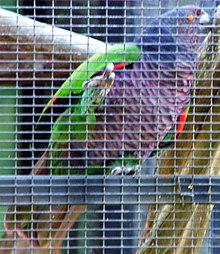Sisserou parrot
| Imperial amazon | |
|---|---|
 |
|
| At the Parrot Conservation and Research Centre, Roseau, Dominica | |
| Scientific classification | |
| Kingdom: | Animalia |
| Phylum: | Chordata |
| Class: | Aves |
| Order: | Psittaciformes |
| Superfamily: | Psittacoidea |
| Family: | Psittacidae |
| Subfamily: | Arinae |
| Tribe: | Androglossini |
| Genus: | Amazona |
| Species: | A. imperialis |
| Binomial name | |
|
Amazona imperialis Richmond, 1899 |
|
The imperial amazon (Amazona imperialis), also known as the sisserou, is a parrot found only on the Caribbean island of Dominica, specifically within the 90 km2 (35 sq mi) of mountainous rainforest near the Morne Diablotins and the Morne Trois Pitons National Park.
The imperial amazon measures an average of 48 cm (19 in) in length. With males weighing an average of 900 g (32 oz) and females 650 g (23 oz), the species is large for its genus.
Being of the family Psittacidae, the sisserou has zygodactyl feet and a thick, hooked bill with a muscular tongue. This bill is fashioned in such a way that using its hinged mandibles and tongue, the sisserou can easily move food around in its mouth.
Males and females have identical plumage. Adult plumage is very colorful and mostly darkly colored: the chest is a dark shade of purple, and the upper-parts and feathers are a dark shade of green, with black-edged feather tips. The eye-ring is dark brown, with the eye being a mix of orange and red. Juvenile appearance does not differ much, with a higher occurrence of green plumage and strictly brown eyes.
The call of the sisserou resides in the higher frequencies, a loud and even "squeaky" mix between shriek, squawk, and trill. Despite their colorful plumage, the birds are shy, difficult to approach, and will often only travel in groups no larger than three. They are found in pairs or small flocks, sometimes with red-necked amazons. They are good climbers and strong flyers with powerful wings. They prefer to perch on the tops of trees. They are difficult to detect, as they are well camouflaged by their plumage, concealing them from predators while feeding.
As a monogamous bird, the sisserou is extremely loyal to its mate; couples will remain together for the entirety of their lives. Between February and April, nesting occurs and the female will lay a clutch of two white eggs in a deep cavity inside a rainforest tree, with the same tree used year after year. For 26–28 days, the female will incubate the eggs. During fledging, which occurs between June and early September, both parents will take care of and feed the chicks until they are fully feathered and ready to leave the nest. The chicks use typical "begging calls" when hungry, to which either parent will respond with food. Usually only one chick survives to fledging and, typically, sisserou pairs fledge a single chick every other year; however, there have been documented exceptions.
...
Wikipedia

